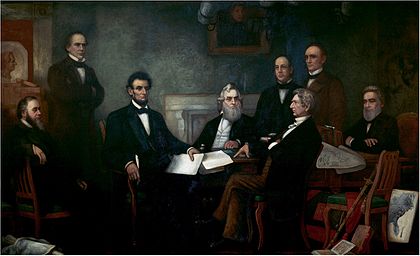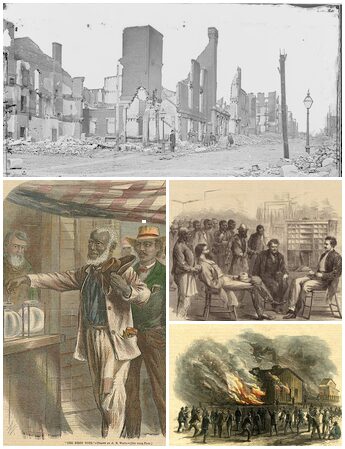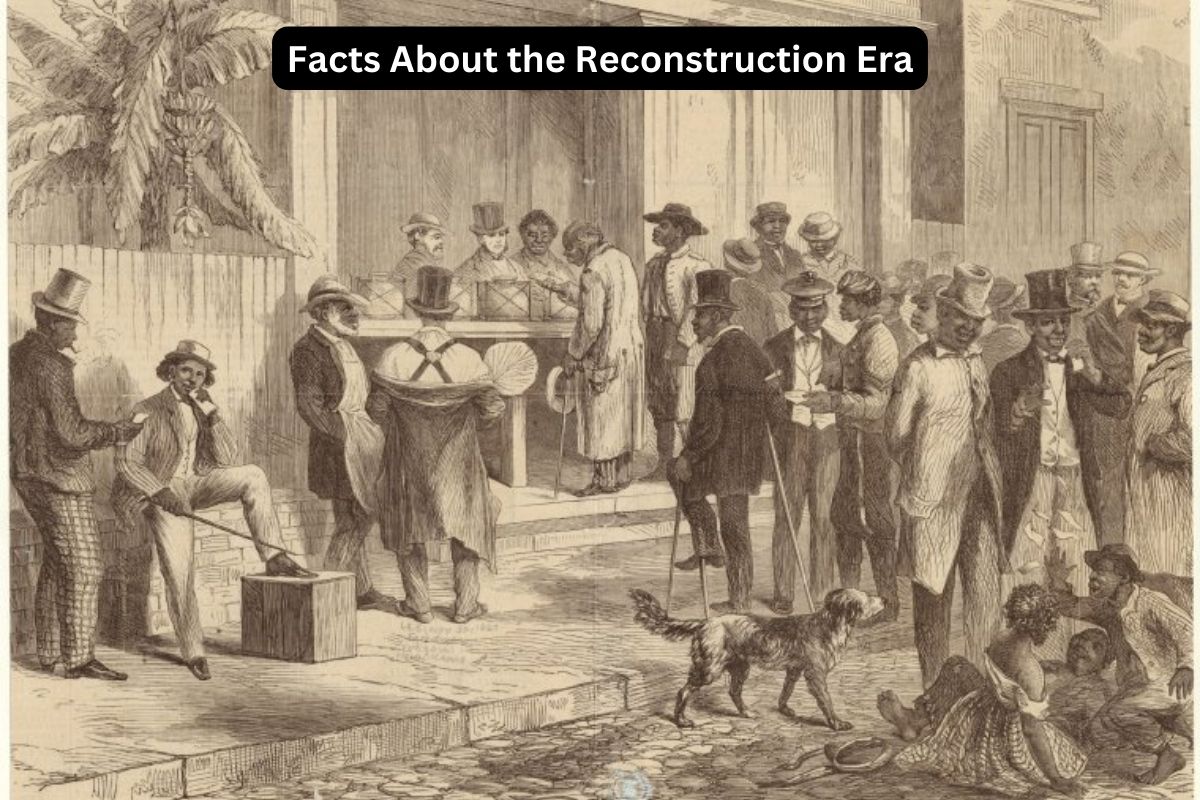The Reconstruction Era in the United States, spanning from 1865 to 1877, was a critical and transformative period immediately following the American Civil War.
This era witnessed a series of historic developments, including the abolition of slavery, the granting of civil rights to African Americans, and a fundamental shift in the political landscape of the South.
However, it was also marred by resistance, violence, and the eventual dismantling of many of these reforms. This brief intro sets the stage for a deeper exploration of the Reconstruction Era’s complexities and its lasting impact on American history.
Reconstruction Era Facts
1. Emancipation Proclamation in 1863
The Emancipation Proclamation was issued by President Abraham Lincoln on January 1, 1863, during the American Civil War.
It declared that all enslaved people in Confederate-held territory were to be set free. However, it did not immediately free all enslaved individuals, as it only applied to areas under Confederate control.
Also Read: Reconstruction Era Timeline
The proclamation was a significant turning point in the war as it reframed the conflict from solely preserving the Union to also being about ending slavery.
It paved the way for the Thirteenth Amendment, which would ultimately abolish slavery throughout the entire United States.

2. Thirteenth Amendment abolished slavery in 1865
The Thirteenth Amendment to the United States Constitution was ratified on December 6, 1865, following the end of the Civil War.
This amendment officially abolished slavery in the United States, making it unconstitutional to own or hold enslaved individuals anywhere in the country.
The Thirteenth Amendment was a critical step in the process of Reconstruction, as it aimed to address one of the primary issues that had led to the Civil War: the institution of slavery.
3. Establishment of the Freedmen’s Bureau
The Freedmen’s Bureau, officially known as the Bureau of Refugees, Freedmen, and Abandoned Lands, was established by Congress on March 3, 1865.
Its primary mission was to assist and support the millions of formerly enslaved individuals and refugees who were transitioning to freedom after the Civil War.
The Freedmen’s Bureau provided various forms of aid, including food, clothing, education, and medical care, to help African Americans and other displaced individuals rebuild their lives.
Additionally, it played a role in securing land and property rights for formerly enslaved people and helped establish schools for African American children in the South.
4. Reconstruction Acts divided the South in 1867
In 1867, Congress passed a series of Reconstruction Acts that aimed to reshape the Southern states and establish a framework for their readmission to the Union.
These acts divided the South into military districts, each under the control of a Union military commander. The Southern states had to draft new state constitutions granting voting rights to African American men and ratify the Fourteenth Amendment to be readmitted.
The Reconstruction Acts also mandated the registration of eligible voters, including African Americans, and set the stage for the reorganization of Southern governments.

5. African American suffrage through the Fourteenth and Fifteenth Amendments
The Fourteenth Amendment to the United States Constitution, ratified in 1868, granted citizenship to all people born or naturalized in the U.S. This included African Americans, overturning the Dred Scott v. Sandford decision that denied them citizenship.
The Fifteenth Amendment, ratified in 1870, prohibited the denial of the right to vote based on race, color, or previous condition of servitude. This amendment aimed to ensure that African American men could exercise their right to vote in the Southern states.
6. Rise of Black political participation
The Reconstruction Era saw a significant increase in African American political participation. Many African Americans, including former slaves, actively engaged in politics.
African Americans were elected to various political offices, ranging from local positions to the U.S. Congress. Notable figures like Hiram Revels and Blanche K. Bruce became some of the first African Americans to serve in the U.S. Senate.
African American participation in politics was a remarkable achievement during this time, as it marked a departure from the pre-war era when they were largely denied political rights.
7. Reconstruction Amendments (13th, 14th, and 15th)
These three amendments to the United States Constitution were ratified during the Reconstruction Era and played a crucial role in reshaping the nation’s legal landscape:
- The Thirteenth Amendment (1865) abolished slavery throughout the United States.
- The Fourteenth Amendment (1868) granted citizenship to all individuals born or naturalized in the U.S., ensuring equal protection under the law.
- The Fifteenth Amendment (1870) prohibited the denial of voting rights based on race, color, or previous condition of servitude, guaranteeing African American men the right to vote.
Collectively, these amendments aimed to secure the civil rights of formerly enslaved individuals and ensure their full participation in American society.
8. Civil Rights Act of 1866
The Civil Rights Act of 1866 was the first major piece of legislation enacted by Congress to address civil rights issues after the Civil War.
This act granted citizenship to all individuals born in the United States, regardless of their race or previous condition of servitude.
It was designed to provide a legal foundation for the protection of the newly emancipated African Americans’ civil rights, including the right to make contracts, own property, and have access to the courts.
9. Opposition and violence against Reconstruction
The Reconstruction Era was marked by resistance from white supremacists who opposed the changes and rights granted to African Americans.
Groups like the Ku Klux Klan emerged, engaging in acts of terror against African Americans, their white allies, and those working to enforce federal laws.
Numerous race riots and acts of violence occurred, making it a tumultuous period in the South as white supremacists sought to undermine the progress made during Reconstruction.
10. End of Reconstruction with the Compromise of 1877
The Compromise of 1877 marked the end of the Reconstruction Era. It was a political deal between Republicans and Democrats following the disputed presidential election of 1876.
As part of the compromise, federal troops were withdrawn from the South, effectively ending the federal government’s efforts to protect the civil rights of African Americans in the region.
The withdrawal of federal troops allowed Southern states to implement Jim Crow laws, which imposed racial segregation and denied African Americans their civil rights, including the right to vote.
The end of Reconstruction marked a tragic reversal of many of the gains made during the era and ushered in a period of racial discrimination and segregation that would persist for decades in the Southern United States.
